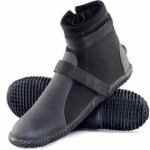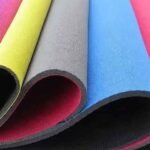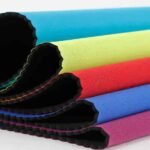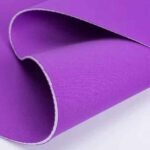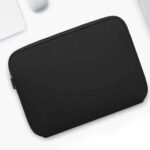Have you ever wondered how the versatile, durable material known as neoprene is created? From wetsuits to laptop bags, neoprene has become essential in countless industries, but few know the journey it takes from raw material to finished product. Understanding how neoprene is made can not only deepen your appreciation for this material but also help you make informed choices when sourcing or using neoprene products.
Neoprene is made through a complex process that begins with chloroprene, a chemical compound derived from petroleum. It undergoes polymerization to create neoprene sheets, which are then processed for various applications.
Let’s dive into the fascinating process behind neoprene manufacturing and explore its many uses, customization options, and sustainability considerations.
What is Neoprene?
Neoprene is a synthetic rubber with exceptional properties that make it ideal for a variety of uses. It was first developed by DuPont in the 1930s as a substitute for natural rubber. Today, it is widely known for its flexibility, durability, and resistance to water, chemicals, and temperature extremes.
Neoprene is made from chloroprene, a chemical compound that is polymerized to create synthetic rubber. It has unique properties such as elasticity, thermal insulation, and waterproofing, making it ideal for industrial and consumer applications.
Neoprene stands out because of its adaptability. Whether used in wetsuits, car seat covers, or industrial machinery, neoprene combines practicality with performance. These qualities make it a material of choice for various industries, which we will explore next.
Which industries commonly use neoprene?
Neoprene is ubiquitous, serving as a critical material in industries ranging from fashion to automotive to healthcare. Its ability to withstand harsh environments while maintaining its integrity has made it indispensable.
Neoprene is widely used in industries like fashion, automotive, construction, healthcare, and sports. Its durability and versatility make it suitable for applications like wetsuits, gloves, seat covers, and braces.
Applications Across Industries
- Fashion: Stylish and functional neoprene bags and apparel.
- Automotive: Durable seat covers and gaskets.
- Sports: Wetsuits, knee braces, and yoga mats.
- Healthcare: Support braces and medical equipment.
With its broad applicability, neoprene continues to be an innovative material that meets diverse industrial needs. Its manufacturing process is equally fascinating.
What is the process of making neoprene?
Creating neoprene involves precise chemical processes that transform raw materials into a versatile synthetic rubber. The journey begins with the chemical compound chloroprene, derived from petroleum or limestone.
Neoprene is made through a process called polymerization. Chloroprene molecules are chemically bonded to form polymers, which are then stabilized and processed into sheets. These sheets can be further shaped and customized for various applications.
Steps in Neoprene Production
- Chloroprene Extraction: Chloroprene is extracted from raw materials like petroleum or limestone.
- Polymerization: Chloroprene molecules are combined into long chains to create neoprene rubber.
- Vulcanization: Heat and pressure are applied to improve the material’s strength and elasticity.
- Sheet Formation: The rubber is formed into sheets of varying thickness and density.
- Cutting and Customization: Sheets are cut and tailored for specific products, such as wetsuits or gaskets.
This meticulous process ensures that neoprene maintains its superior quality, ready to be customized for different purposes.
How do manufacturers customize neoprene?
Manufacturers tailor neoprene to meet specific customer requirements. Customization enhances the material’s functionality and aesthetic appeal, catering to industries with unique needs.
Manufacturers customize neoprene by altering its thickness, density, and surface treatments. They also add colors, patterns, and functional coatings to match customer requirements.
Customization Techniques
- Thickness Adjustment: Thinner neoprene for flexibility or thicker sheets for insulation.
- Surface Coatings: Anti-slip, waterproof, or UV-resistant finishes.
- Printing and Dyes: Logos, patterns, and vibrant colors for branding and aesthetics.
Why Customization Matters
Customization not only adds value but also ensures that neoprene products align with specific industrial or consumer demands. For instance:
- Fashion: Custom neoprene bags with logos.
- Sports: Neoprene wetsuits tailored for thermal insulation.
With these options, manufacturers can create bespoke solutions that meet the needs of even the most demanding clients.
What are the environmental considerations in neoprene production?
Despite its many benefits, neoprene production raises environmental concerns due to its reliance on non-renewable resources. However, manufacturers are increasingly adopting sustainable practices.
The main environmental issues in neoprene production stem from its reliance on petroleum-based materials. Efforts to mitigate these include using limestone-derived chloroprene and recycling waste materials.
Sustainable Practices in Neoprene Manufacturing
- Limestone-Based Neoprene: Replacing petroleum with limestone reduces carbon emissions.
- Waste Recycling: Reusing production scraps minimizes material waste.
- Eco-Friendly Coatings: Water-based adhesives instead of solvent-based ones.
Balancing Performance and Sustainability
While neoprene is durable and long-lasting, manufacturers and customers must weigh its environmental impact. Supporting eco-friendly production practices can help minimize the ecological footprint of neoprene products.
Conclusion
Neoprene’s journey from chloroprene to finished product is as versatile as the material itself. From wetsuits to custom bags, it supports countless industries with its durability, flexibility, and waterproof properties. Understanding how neoprene is made highlights its value and showcases the innovation behind its production.
At Szoneier, we bring over a decade of experience in neoprene manufacturing. Our state-of-the-art facility offers customization options tailored to your brand’s needs, including free samples, flexible MOQs, and fast lead times. Whether you’re looking for custom neoprene koozies, bags, or wetsuits, we provide the quality, reliability, and sustainability your business demands.
Contact us today at info@neoprene-bag.com or visit our website at www.neoprene-bag.com to learn more about our offerings and request a quote. Let’s work together to create exceptional neoprene products that set your brand apart.



